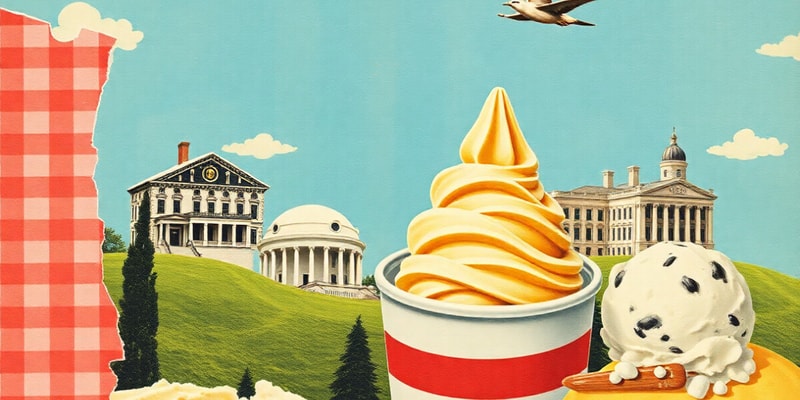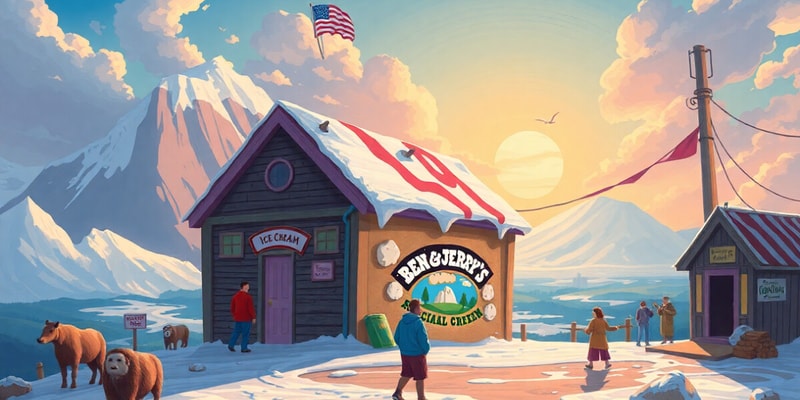Podcast
Questions and Answers
What was the initial business idea of Ben Cohen and Jerry Greenfield before venturing into ice cream?
What was the initial business idea of Ben Cohen and Jerry Greenfield before venturing into ice cream?
Which of the following best describes the foundational philosophy of Ben & Jerry's?
Which of the following best describes the foundational philosophy of Ben & Jerry's?
What percentage of pre-tax profits did the Ben & Jerry's Foundation allocate to grassroots projects?
What percentage of pre-tax profits did the Ben & Jerry's Foundation allocate to grassroots projects?
What year did Ben & Jerry's achieve national distribution across the United States?
What year did Ben & Jerry's achieve national distribution across the United States?
Signup and view all the answers
Which characteristic is NOT associated with the superpremium ice cream segment?
Which characteristic is NOT associated with the superpremium ice cream segment?
Signup and view all the answers
What unique feature characterized Ben & Jerry's first scoop shop?
What unique feature characterized Ben & Jerry's first scoop shop?
Signup and view all the answers
During the 1980s, Ben & Jerry's was known for innovating in which area?
During the 1980s, Ben & Jerry's was known for innovating in which area?
Signup and view all the answers
What was the approximate annual value of the ice cream industry in the United States during the 1990s?
What was the approximate annual value of the ice cream industry in the United States during the 1990s?
Signup and view all the answers
What was a significant issue faced during the opening of the new Vermont factory?
What was a significant issue faced during the opening of the new Vermont factory?
Signup and view all the answers
How many flavors had Ben & Jerry's expanded to by 1994?
How many flavors had Ben & Jerry's expanded to by 1994?
Signup and view all the answers
What percentage of total sales was driven by Chocolate Chip Cookie Dough in 1992?
What percentage of total sales was driven by Chocolate Chip Cookie Dough in 1992?
Signup and view all the answers
What type of marketing did Ben & Jerry's traditionally rely on before increased competition?
What type of marketing did Ben & Jerry's traditionally rely on before increased competition?
Signup and view all the answers
Which joint venture showed promise for Ben & Jerry's despite challenges?
Which joint venture showed promise for Ben & Jerry's despite challenges?
Signup and view all the answers
What percentage of pre-tax profits did the Ben & Jerry's Foundation allocate to community projects?
What percentage of pre-tax profits did the Ben & Jerry's Foundation allocate to community projects?
Signup and view all the answers
What was a key element of Ben & Jerry's organizational culture?
What was a key element of Ben & Jerry's organizational culture?
Signup and view all the answers
Which flavor development initiative required a $6 million advertising campaign?
Which flavor development initiative required a $6 million advertising campaign?
Signup and view all the answers
What percentage of the market did premium ice cream account for in 1994?
What percentage of the market did premium ice cream account for in 1994?
Signup and view all the answers
Which competitor dominated the superpremium segment in the ice cream market?
Which competitor dominated the superpremium segment in the ice cream market?
Signup and view all the answers
Which product gained 17% of the superpremium market by 1994 due to changing consumer behavior?
Which product gained 17% of the superpremium market by 1994 due to changing consumer behavior?
Signup and view all the answers
What was the primary challenge that Ben & Jerry's faced regarding its revenue in the mid-1990s?
What was the primary challenge that Ben & Jerry's faced regarding its revenue in the mid-1990s?
Signup and view all the answers
What was a significant impact of the FDA labeling requirements introduced in 1994?
What was a significant impact of the FDA labeling requirements introduced in 1994?
Signup and view all the answers
Who took over as CEO of Ben & Jerry's in 1995?
Who took over as CEO of Ben & Jerry's in 1995?
Signup and view all the answers
What was the net income of Ben & Jerry's in 1994 compared to the previous year?
What was the net income of Ben & Jerry's in 1994 compared to the previous year?
Signup and view all the answers
What operational issue was highlighted regarding Ben & Jerry’s production strategies?
What operational issue was highlighted regarding Ben & Jerry’s production strategies?
Signup and view all the answers
Study Notes
Historical Context and Founding Vision
- Ben & Jerry's was founded in 1978 by Ben Cohen and Jerry Greenfield.
- They started with a bagel business idea, but later pivoted to ice cream.
- They completed a correspondence course on ice cream making from Penn State University.
- Their initial vision included social justice, environmental sustainability, and community engagement.
Foundational Philosophy
- Ben & Jerry's had a dual focus: product excellence and social responsibility.
- They aimed to provide premium-quality ice cream with innovative flavors.
- They sought social change through company initiatives, local sourcing and fair labor practices.
Growth in the 1980s
- Ben & Jerry's expanded from a local Vermont brand to a national company in the 1980s.
- They became well-known for their whimsical packaging and innovative flavors (e.g., Chunky Monkey, Cherry Garcia).
- The company experienced significant growth, achieving 60% annual growth by 1990.
The Ice Cream Industry Landscape
- The US ice cream market in the 1990s was valued at $10.5 billion.
- Ben & Jerry's operated in the superpremium ice cream segment.
- This segment was characterized by high butterfat content and low air overrun, creating a richer, creamier product.
Industry Segments
- Superpremium (13% market share), Ben & Jerry's and Häagen-Dazs fell into this category.
- Premium and regular ice cream.
- Health conscious alternatives (frozen yogurt, sherbets, low-fat ice creams).
Market Challenges
- Intense competition: Häagen-Dazs and Dreyer's were major competitors.
- Shifts in consumer behavior, consumers favored healthier options (frozen yogurt).
- Distribution battles for shelf space.
Ben & Jerry's Challenges in the 1990s
- Slowing sales growth, increasing only marginally from $140 million in 1993 to $149 million in 1994.
- First quarterly loss in December 1994, due to production issues and inventory management.
- Decrease in net income to a loss of $1.87 million in 1994 compared to $7.2 million in 1993.
Leadership Transition
- Ben Cohen stepped down as CEO in 1994 to focus on experienced leadership.
- Bob Holland was appointed as the new CEO in 1995.
Operational Inefficiencies
- Reliance on Dreyer's for outsourced production (vulnerable and costly).
- Challenges in producing mix-in flavors with large chunks (complex and costly).
- Rapid expansion of flavors led to supply chain and inventory management issues (overstock and shortages).
Strategic Initiatives
- Ben & Jerry's aimed to combat challenging conditions through various strategic initiatives.
- They focused on flavor development with new and popular flavors like Chocolate Chip Cookie Dough.
- They tried to target new segments like health-conscious consumers by adding frozen yogurt.
- Increased marketing efforts, including social media initiatives and traditional advertising for significant brand awareness.
Social Mission
- This aspect underscored their commitment to social activism, which led to both support and controversy (e.g., community projects and ethical sourcing).
Organizational Culture
- Ben & Jerry's emphasized progressive human resource policies like casual dress and a 5:1 salary ratio.
- This focused on egalitarian ethos but also created challenges (recruiting competent executives).
The Role of Bob Holland
- As the first outside CEO, his role was crucial to professionalizing operations while retaining the brand identity.
- He focused on addressing inefficiencies in manufacturing and distribution.
Future Outlook
- The company's future depended on global expansion, optimizing production, and managing market adaptations to maintain relevance in a competitive landscape.
Operational Improvements/Market Adaptation/Global Expansion
- These were core elements of future strategies for the company.
Conclusion
- Ben & Jerry's faced challenges in scaling their socially responsible business.
- The case highlighted the complexities of integrating profit-driven growth with social commitment and environmental responsibility in a changing marketplace.
Studying That Suits You
Use AI to generate personalized quizzes and flashcards to suit your learning preferences.
Related Documents
Description
Explore the founding history and foundational philosophy of Ben & Jerry's. This quiz covers their transition from a bagel business to a national ice cream brand, their commitment to social responsibility, and their innovative flavors. Test your knowledge of how their vision shaped the company and the ice cream industry.




